From The Trenches
Livestock for the Afterlife
By ZACH ZORICH
Friday, October 05, 2012
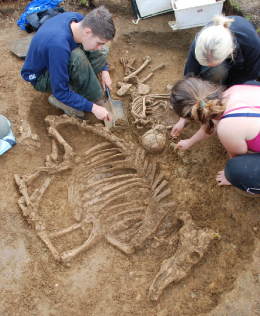 In Oakington, England, a team of archaeologists led by Duncan Sayer of the University of Central Lancashire has excavated a late-fifth-century A.D. Anglo-Saxon grave containing the remains of a wealthy woman and a cow. The grave is the first of its kind in Europe. “It matches the female role in Anglo-Saxon society,” says Sayer. “The cow was much more a symbol of economic and domestic power.”
In Oakington, England, a team of archaeologists led by Duncan Sayer of the University of Central Lancashire has excavated a late-fifth-century A.D. Anglo-Saxon grave containing the remains of a wealthy woman and a cow. The grave is the first of its kind in Europe. “It matches the female role in Anglo-Saxon society,” says Sayer. “The cow was much more a symbol of economic and domestic power.”
Settling Southeast Asia
By ZACH ZORICH
Friday, October 05, 2012
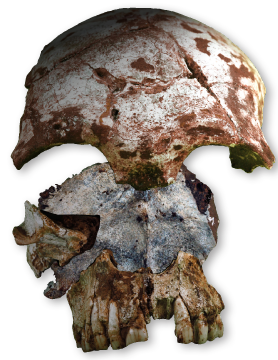 Fragments of a human skull found at Tam Pa Ling Cave in Laos, dated to between 46,000 and 63,000 years old, are providing insights into how the first Homo sapiens settled Southeast Asia and later Australia. Archaeologists Fabrice Demeter of the National Museum of Natural History in Paris and Laura Shackelford of the Illinois State Geological Survey analyzed the skull. According to Shackelford, it does not show any evidence that the individual’s ancestors interbred with Homo erectus, a hominin species that lived in the area for more than one million years. The skull itself is small and belonged to a young adult at least 18 years old. No artifacts were found with the bones, but the cave’s location, far from the coast, shows that modern humans migrated through the river valleys and into the mountains of Laos as they continued their trek toward Australia, where they arrived at least 40,000 years ago.
Fragments of a human skull found at Tam Pa Ling Cave in Laos, dated to between 46,000 and 63,000 years old, are providing insights into how the first Homo sapiens settled Southeast Asia and later Australia. Archaeologists Fabrice Demeter of the National Museum of Natural History in Paris and Laura Shackelford of the Illinois State Geological Survey analyzed the skull. According to Shackelford, it does not show any evidence that the individual’s ancestors interbred with Homo erectus, a hominin species that lived in the area for more than one million years. The skull itself is small and belonged to a young adult at least 18 years old. No artifacts were found with the bones, but the cave’s location, far from the coast, shows that modern humans migrated through the river valleys and into the mountains of Laos as they continued their trek toward Australia, where they arrived at least 40,000 years ago.
The Bog Army
By JARRETT A. LOBELL
Friday, October 05, 2012
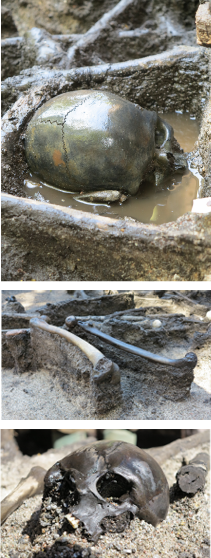 When the team of archaeologists from Aarhus University began finding human bones in Alken Enge bog in eastern Denmark three years ago, they weren’t sure what to think—but they knew they wanted to return. After more than two months in the field this past summer, they have now recorded the remains of nearly 250 individuals, as well as spearheads, shields, clubs, and an ax, all part of what project archaeologist Mads Holst believes is evidence for a catastrophic military event that occurred around A.D. 1. At this time the Roman Empire had reached its northern boundary just 185 miles south of Alken, resulting in turmoil and increased militarization of the local tribes in response to the empire’s expansion. According to Holst, it appears that the soldiers from the bog, a unique find in northern Europe, may have been killed in battle—their wounds are consistent with battle damage—and then buried in the bog in some sort of ritual.
When the team of archaeologists from Aarhus University began finding human bones in Alken Enge bog in eastern Denmark three years ago, they weren’t sure what to think—but they knew they wanted to return. After more than two months in the field this past summer, they have now recorded the remains of nearly 250 individuals, as well as spearheads, shields, clubs, and an ax, all part of what project archaeologist Mads Holst believes is evidence for a catastrophic military event that occurred around A.D. 1. At this time the Roman Empire had reached its northern boundary just 185 miles south of Alken, resulting in turmoil and increased militarization of the local tribes in response to the empire’s expansion. According to Holst, it appears that the soldiers from the bog, a unique find in northern Europe, may have been killed in battle—their wounds are consistent with battle damage—and then buried in the bog in some sort of ritual.
Holst is certain there is a great deal more to uncover and to learn. “We have only excavated about 1,600 square feet so far, just a small part of the complex. But we know from surveying and doing small test excavations that there are finds from an area that covers almost 100 acres,” says Holst. “The scale of the conflict is much larger than we expected and reveals a much higher level of organization than most ancient descriptions of these tribes would have you believe.”
Who Came to America First?
By NIKHIL SWAMINATHAN
Friday, October 05, 2012
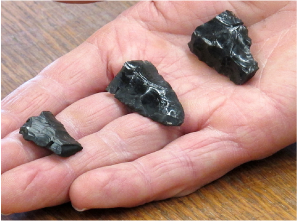 In 2008, archaeologists working at Paisley Caves in central Oregon presented evidence, in the form of coprolites, or fossilized feces, of human occupation in the Americas dating back more than 14,000 years. That’s 1,000 years before the emergence of the Clovis culture, the previously agreed-upon first Americans. Critics discounted the findings because no tools had been found with the coprolites. They asserted that human DNA found on the feces might have washed down onto the droppings over time.
In 2008, archaeologists working at Paisley Caves in central Oregon presented evidence, in the form of coprolites, or fossilized feces, of human occupation in the Americas dating back more than 14,000 years. That’s 1,000 years before the emergence of the Clovis culture, the previously agreed-upon first Americans. Critics discounted the findings because no tools had been found with the coprolites. They asserted that human DNA found on the feces might have washed down onto the droppings over time.
This summer the Paisley Caves team presented new evidence from the cave, including stone tools and radiocarbon dates for them and the coprolites—all as many as 13,200 years old. The Paisley Caves tools belong to the so-called Western Stemmed tradition, and are markedly different from Clovis tools, which are best exemplified by their fluted, Christmas tree–shaped projectile points. Loren Davis, an archaeologist at Oregon State University and part of the Paisley Caves team, says that Clovis points were made from large stone cores, while the Western Stemmed tools were fashioned from stone fragments.
Davis says the findings indicate that another population was here at the same time, or possibly before, Clovis, requiring a new model for the peopling of the Americas. “It can’t be a straight-line evolutionary model where everything descends from Clovis,” he explains. “Now the scene early on is very complicated.”
Medieval Fashion Statement
By JARRETT A. LOBELL
Friday, October 05, 2012
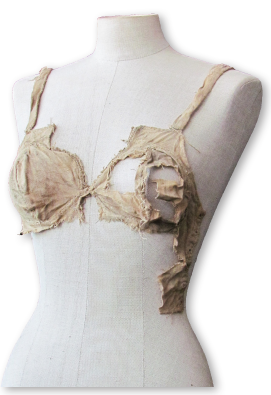 When archaeologists pulled up the floorboards during extensive restoration work at Lengberg Castle in Austria, they found a space filled with dry organic material, including branches and straw, processed wood, leather, shoes, yarn, rope, and more than 2,700 textile fragments. Among the textiles were 17 linen shirts, a complete pair and a fragment of men’s underwear, and four lace-decorated linen bras—which push back the earliest date for this type of women’s undergarment more than 500 years. Using both their archaeological context—the fill layer was likely created during a fifteenth-century renovation of the castle—and radiocarbon analysis of fibers from two of the bras, Beatrix Nutz of the University of Innsbruck dated the garments to between A.D. 1390 and 1485. There are numerous medieval written sources that describe bras as “breastbags,” but until this discovery no one had any idea what these garments looked like. According to Nutz, we also know from contemporary sources that women likely made the garments themselves and did not rely on male tailors. The discovery will enable archaeologists and clothing historians to learn more about tailoring by women.
When archaeologists pulled up the floorboards during extensive restoration work at Lengberg Castle in Austria, they found a space filled with dry organic material, including branches and straw, processed wood, leather, shoes, yarn, rope, and more than 2,700 textile fragments. Among the textiles were 17 linen shirts, a complete pair and a fragment of men’s underwear, and four lace-decorated linen bras—which push back the earliest date for this type of women’s undergarment more than 500 years. Using both their archaeological context—the fill layer was likely created during a fifteenth-century renovation of the castle—and radiocarbon analysis of fibers from two of the bras, Beatrix Nutz of the University of Innsbruck dated the garments to between A.D. 1390 and 1485. There are numerous medieval written sources that describe bras as “breastbags,” but until this discovery no one had any idea what these garments looked like. According to Nutz, we also know from contemporary sources that women likely made the garments themselves and did not rely on male tailors. The discovery will enable archaeologists and clothing historians to learn more about tailoring by women.
Advertisement
Advertisement
IN THIS ISSUE
From The Trenches
The Desert and the Dead
Fractals and Pyramids
Off the Grid
Mosaics of Huqoq
Medieval Fashion Statement
The Bog Army
Who Came to America First?
Settling Southeast Asia
Livestock for the Afterlife
Running Guns to Irish Rebels
High Rise of the Dead
Diagnosis of Ancient Illness
Pharaoh’s Port?
Peru’s Mysterious Infant Burials
Advertisement

Recent Issues
-
 May/June 2024
May/June 2024
-
 March/April 2024
March/April 2024
-
 January/February 2024
January/February 2024
-
 November/December 2023
November/December 2023
-
 September/October 2023
September/October 2023
-
 July/August 2023
July/August 2023
-
 May/June 2023
May/June 2023
-
 March/April 2023
March/April 2023
-
 January/February 2023
January/February 2023
-
 November/December 2022
November/December 2022
-
 September/October 2022
September/October 2022
-
 July/August 2022
July/August 2022
-
 May/June 2022
May/June 2022
-
 March/April 2022
March/April 2022
-
 January/February 2022
January/February 2022
-
 November/December 2021
November/December 2021
-
 September/October 2021
September/October 2021
-
 July/August 2021
July/August 2021
-
 May/June 2021
May/June 2021
-
 March/April 2021
March/April 2021
-
 January/February 2021
January/February 2021
-
 November/December 2020
November/December 2020
-
 September/October 2020
September/October 2020
-
 July/August 2020
July/August 2020
-
 May/June 2020
May/June 2020
-
 March/April 2020
March/April 2020
-
 January/February 2020
January/February 2020
-
 November/December 2019
November/December 2019
-
 September/October 2019
September/October 2019
-
 July/August 2019
July/August 2019
-
 May/June 2019
May/June 2019
-
 March/April 2019
March/April 2019
-
 January/February 2019
January/February 2019
-
 November/December 2018
November/December 2018
-
 September/October 2018
September/October 2018
-
 July/August 2018
July/August 2018
-
 May/June 2018
May/June 2018
-
 March/April 2018
March/April 2018
-
 January/February 2018
January/February 2018
-
 November/December 2017
November/December 2017
-
 September/October 2017
September/October 2017
-
 July/August 2017
July/August 2017
-
 May/June 2017
May/June 2017
-
 March/April 2017
March/April 2017
-
 January/February 2017
January/February 2017
-
 November/December 2016
November/December 2016
-
 September/October 2016
September/October 2016
-
 July/August 2016
July/August 2016
-
 May/June 2016
May/June 2016
-
 March/April 2016
March/April 2016
-
 January/February 2016
January/February 2016
-
 November/December 2015
November/December 2015
-
 September/October 2015
September/October 2015
-
 July/August 2015
July/August 2015
-
 May/June 2015
May/June 2015
-
 March/April 2015
March/April 2015
-
 January/February 2015
January/February 2015
-
 November/December 2014
November/December 2014
-
 September/October 2014
September/October 2014
-
 July/August 2014
July/August 2014
-
 May/June 2014
May/June 2014
-
 March/April 2014
March/April 2014
-
 January/February 2014
January/February 2014
-
 November/December 2013
November/December 2013
-
 September/October 2013
September/October 2013
-
 July/August 2013
July/August 2013
-
 May/June 2013
May/June 2013
-
 March/April 2013
March/April 2013
-
 January/February 2013
January/February 2013
-
 November/December 2012
November/December 2012
-
 September/October 2012
September/October 2012
-
 July/August 2012
July/August 2012
-
 May/June 2012
May/June 2012
-
 March/April 2012
March/April 2012
-
 January/February 2012
January/February 2012
-
 November/December 2011
November/December 2011
-
 September/October 2011
September/October 2011
-
 July/August 2011
July/August 2011
-
 May/June 2011
May/June 2011
-
 March/April 2011
March/April 2011
-
 January/February 2011
January/February 2011
Advertisement






